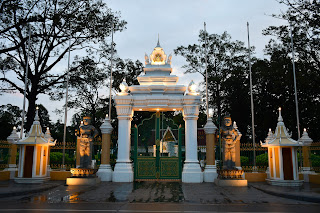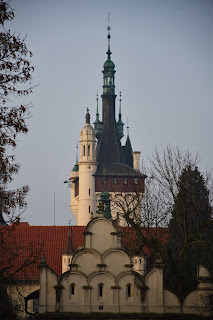Luang Prabang to Angkor – Day 8: Siem Reap
Today was our last day in Laos. We ate a slow breakfast and asked the front desk to arrange a van to the airport, which was ready in about half an hour. Joining us was a group of Canadian tourists who seemed completely nonplussed about getting to the airport just minutes before their flight to Saigon. We, on the other hand, arrived over an hour early, which gave us plenty of time to check in and fill out the e-entry form to Cambodia: We were only informed of this obligation by the lady at the check-in counter, but at least she saved us time at the airport in Siam Reap.
We arrived
at the airport in Siam Reap well before noon. However, our timeliness did not
come in very handy, as we needed to wait for a bus to take us to the centre of
the city, which lies about an hour away. Taking a taxi would have cost us over
twice as much, so we sat down at an airport restaurant and ate a small lunch.
That is, I ate a small lunch, as I had given Barron the hamburger I was served
on the aeroplane. We compensated for this neglect many times over in the
evening, when we visited a restaurant with a ten-course tasting menu for forty
dollars. Neither of us knew this beforehand, but I felt too awkward to leave
once I found out, and Barron wanted to give it a try.
We did not have
all that much time to kill. Having arrived past two o’clock, we walked from the
bus station to Wat Bo and from there to Wat Damnak. The latter temple is an
interesting one: beside its worn stupas, it also has a small cemetery with
large and ornate family crypts. After checking in at our hotel, I called us a Grab
to the Angkor National Museum. Unlike Grab in Bangkok, the local version of the
application in Siem Reap includes tuk-tuks, which are generally much cheaper to
rent than cars. However, tuk-tuk drivers often do not carry around much change,
so we had to ask our driver to wait outside the museum while we bought tickets
to break our 20,000 bill.
The museum is
well organised even if formidably expensive. Distributed across two floors, its
halls are separated thematically and geographically. An entire room on the
second floor dedicated to Buddha images, which allows for an instructive
explanation of the mudras. On the first floor (which, paradoxically, one visits
only after touring the second), one room houses objects from Angkor Wat, while
another contains artefacts from Angkor Thom. These are further sorted by
category and age, with all the tympani, for example, grouped together. A
representative sample of statues of gods from the Hindu pantheon can be found
on the first floor.























Comments
Post a Comment